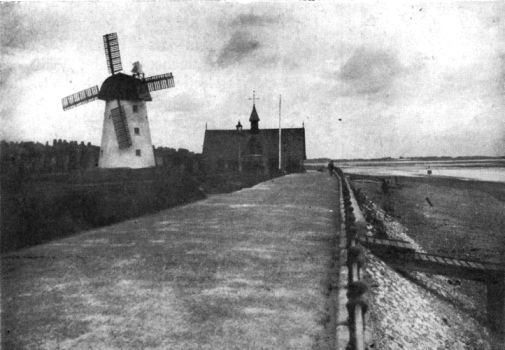|
1930
LAST LYTHAM
MILLER.
MR.
WILLIAM SWANN.
Quarter of a Century in the Old Lytham Mill.

LYTHAM'S ANCIENT WINDMILL.
The last tenant of the Lytham windmill, when it
ground corn - today it is a cafe - Mr. William Swann, 58, Warton
Street, Lytham, died on Wednesday at the age of 76 years. He had
been in ill-health for some time. A widow and one son, Harold, are
left to mourn their loss.
Mr. Swann was a native of Treales and he learned
how to grind corn at the village mill. Then he removed to Preston
where he was employed by a firm of millers, and 36 years ago he
came to Lytham. He tenanted the mill for 25 years, his work there
ending when a fire put the mill out of action in January, 1919. He
had a great regard for the old mill and never tired of telling its
history to his many more or less distinguished visitors. He made
half-a-dozen models, five of which were sold at bazaars, and he was
engaged on a seventh when illness made him lay aside his tools.
The Lytham mill, now outwardly but a landmark,
and cleaving the wind just as a reminder of its past glory, has an
interesting history, " R.P.," writing in the " Lytham St. Annes
Express," said some time ago:
"It is said to be the oldest in the country; at
least it was erected on the site of a mill believed to be in
existence in the 12th century. Scores of names were carved on the
oaken beams, and the woodwork and the pillars were covered with
hundreds of visiting cards left by people who had responded to the
miller's invitation - to have a look round.' Many notable people
visited the mill and left their cards, including a Lusitania
survivor, music-hall artistes and other celebrities."
The mill is closely linked with the history of
Lytham; in fact, no history of the town would be complete without
mention of the Mill.
BELONGED TO THE PRIORY.
"Prior to the fire there was a piece of leadwork
in the mill dated 1663. But chroniclers of history tell us that
there was a mill in existence as far back as 1190 [on another
site]. Certainly its history can be dated much further back than
the 17th century. The 'Wyn Milne' is referred to in a deed of 1327
under the hood of the Prior of Lytham. The mill belonged to the
Priory, and in 1337 there was granted a right to one John de
Brede-Kyrke to grind corn at Lytham Mill.
"The present structure was built somewhere about
1760 [1805], which before the fire stopped its work, made it the
oldest working mill in the Fylde. The present sails are merely
dummies and are neither as long nor as heavy as the original sails.
Each of the four sails was forty-five feet long, the span being
ninety feet and the weight twenty tons. To bear the great weight of
these huge sails necessitated a five feet thick at the base.
"The grinding stones were five feet in diameter,
and one of the millstones. came from the old Wrea Green mill about
1860. The millstone had been in use at Wrea Green for nearly a
century. On the central shaft of the mill was the inscription :
This is called the upright shaft—it has done its work for 150
years."
Newspaper cutting from the Lytham
St.Annes Express, 1930.
|